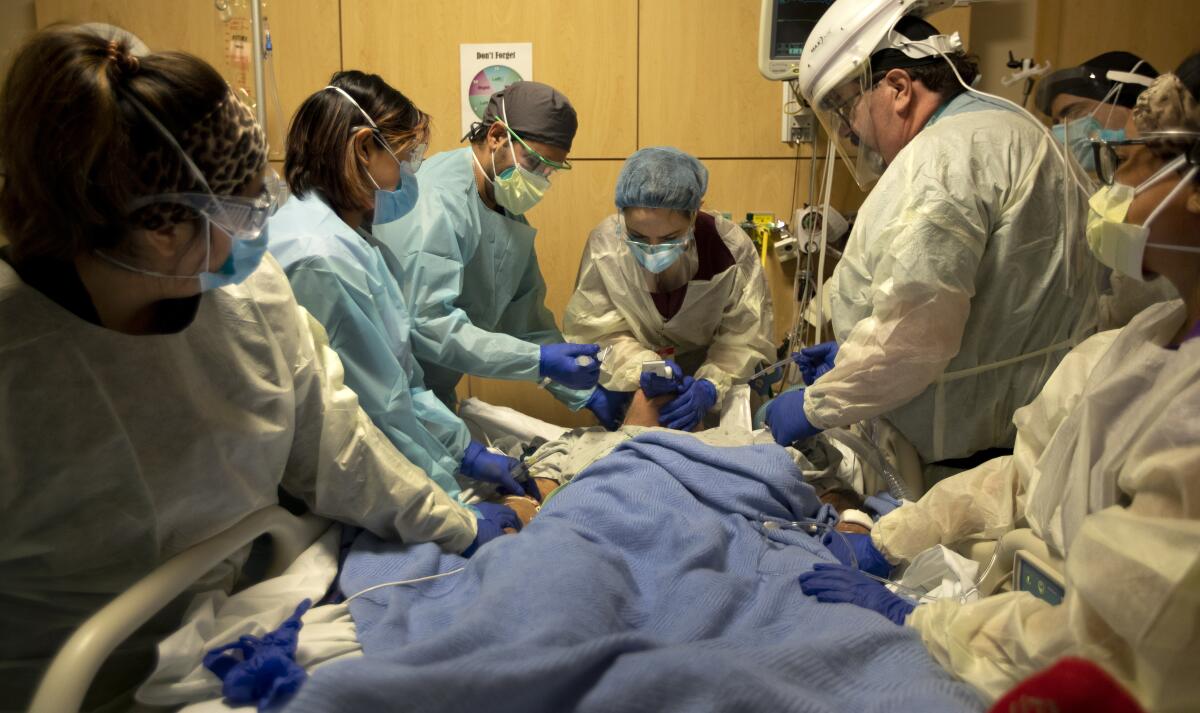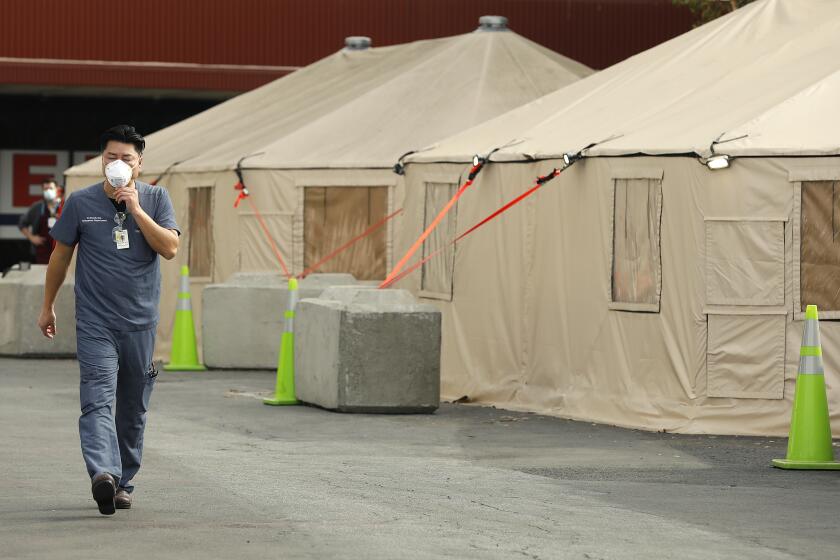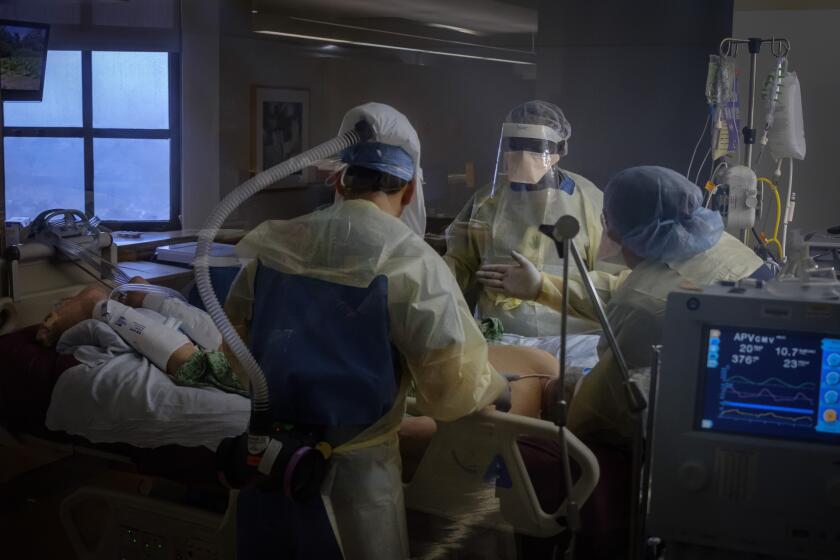L.A. County at ‘catastrophic’ COVID-19 levels, with 13,815 new cases and more than 500,000 total

- Share via
The COVID-19 crisis hit what Los Angeles County officials called “uncharted territory” Friday, as the daily case count surged dramatically to 13,815 and total cases topped 500,000, the latest signs that the virus is spreading with ferocious speed.
“We’re seeing daily numbers of cases and hospitalizations that we’ve not experienced and, frankly, did not anticipate,” said L.A. County Public Health Director Barbara Ferrer. “Our intensive care unit bed capacity continues to drop. We’re on a very dangerous track to seeing unprecedented and catastrophic suffering and death.”
The avalanche of new coronavirus infections is causing hospitals to see a run on patients and pushing some ICUs to — or perilously near — capacity.
As of Thursday, the most recent day for which complete data are available, there were 3,850 COVID-19 patients hospitalized countywide, including 856 in the ICU — both records.
The number of people hospitalized in L.A. County with coronavirus infections has doubled since Thanksgiving and quadrupled since a month ago, when there were 942.
“The best thing we can all do right now is stay in our homes whenever possible and away from people we don’t live with,” Ferrer said during a briefing Friday.
The latest maps and charts on the spread of COVID-19 in Los Angeles County, including cases, deaths, closures and restrictions.
Officials fear the situation will only worsen as more people who may have been exposed to the virus during the Thanksgiving holiday become sick. There is still hope that the new stay-at-home order will make a difference, but it will take weeks before the effects, if any, become apparent.
“We cannot undo what’s already been done, and collectively, we’re going to all pay a very high price for the actions we were taking in the past,” Ferrer said.
At this point, she added, “it’s not a question of if we’ll see a large increase of hospitalizations and deaths” but a question of how severe the numbers will get.
Officials have often said that rising numbers of infections lead to increased hospitalizations two to three weeks later. Two weeks ago, L.A. County was seeing an average of 4,200 new coronavirus cases per day. That wave of infections is what is fueling the current record-high hospitalization numbers.
Should the same proportion hold, the recent average caseload of 10,200 new infections per day will trigger a tidal wave two weeks from now — with potentially more than 7,300 COVID-19 patients in the hospital at once, and nearly 1,700 of them in intensive care.
There are only about 2,100 ICU adult beds across all county hospitals, according to Ferrer.
Orange County official warns that the region’s emergency medical system could be at risk of collapse unless steps are taken to alleviate the stress.
Significant spikes in cases and hospitalizations will invariably lead to increases in fatalities.
Over the last week, an average of 52 Angelenos have died from COVID-19 every day, according to data compiled by The Times. Two weeks from now, “we could witness 80 people dying each day,” Ferrer said.
Already, more than 8,100 L.A. County residents have died from COVID-19.
The unfortunate reality, Ferrer said, is that “what we’re seeing today is not the worst that we’re going to experience.”
“I think the issue right now is this is what we would call the Thanksgiving surge ... now we have a surge on top of a surge,” she said. “And it’s really hard for us to calculate exactly what we’re going to see over the next week or two.”
Public health officials are anxiously tracking the capacity of intensive care units as coronavirus case numbers surge. Why is that metric important?
The illness is clearly spreading into an array of communities like never before.
L.A. County officials this week released data showing big jumps in coronavirus cases in dozens of communities in the San Gabriel Valley, the South Bay, the Westside and central Los Angeles. Communities that saw a more than 200% increase in coronavirus cases between late September and late November include Silver Lake, Claremont, Rosemead, San Gabriel, South El Monte, Hawthorne, Palms, Westchester, Lennox and parts of South Los Angeles.
Officials stress, though, that the coronavirus is so widespread throughout the county that residents should assume that everyone they come into contact with could be infected.
Moving forward, Ferrer said, all residents must take steps to protect themselves from infection — including staying home as much as possible and avoiding mixing with those they do not live with.
“Make the choice today and every day throughout December that you’re going to protect yourself, you’re going to protect your friends and loved ones and you’re going to protect the friends and loved ones of other people,” she said.
It’s too early to consider additional restrictions on businesses and activities on top of what’s already in place countywide, the health director said. The focus at this point is urging people to follow the rules that are already in place.
“I think what we have right now would work if we had almost everybody doing it. I think it will slow the surge,” she said. “We just need everyone to start doing what they need to be doing.”
More to Read
Sign up for Essential California
The most important California stories and recommendations in your inbox every morning.
You may occasionally receive promotional content from the Los Angeles Times.















